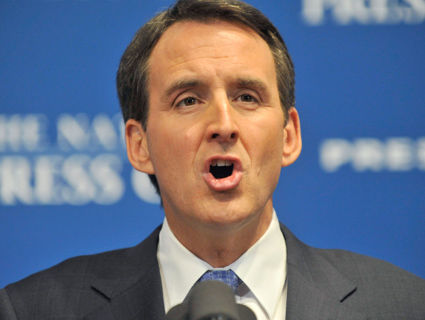
<a href="http://www.flickr.com/photos/marcn/2146444491/sizes/m/in/photostream/">marcn</a>/Flickr
On Tuesday, Republican presidential hopeful Tim Pawlenty delivered the first major economic speech of his campaign, a plan to slash taxes, create jobs, and rev up America’s economic engine. He dubbed it “A Better Deal.” Too bad, as the Washington Post‘s Glenn Kessler points out, Pawlenty’s plan had more holes in it than a slice of Swiss cheese.
In his “Fact Checker” column, Kessler picks apart some of Pawlenty‘s more sweeping statements. Like this one: “Our health care system, thanks to ObamaCare, is more expensive and less efficient.” It doesn’t take an expert to know that President Obama’s health care reform bill doesn’t fully go into effect until 2014, so how can Pawlenty lay the blame on Obama for today’s problems? (Answer: He can’t, at least not truthfully.) What’s more, Pawlenty’s own campaign cited a PricewaterhouseCoopers report (PDF) to support this claim. But as Kessler notes, that same PwC report says, “The law will have minimal effect on the cost trend in 2012.” In other words, Pawlenty’s own evidence directly contradicts his claim.
Then Kessler takes apart this Pawlenty claim:
“Five percent economic growth over 10 years would generate $3.8 trillion in new tax revenues. With that, we would reduce projected deficits by 40 percent. All before we made a single budget cut.”
Earlier in the speech, Pawlenty said that Ronald Reagan in the 1980s and Bill Clinton in the 1990s enjoyed near-five percent economic growth. So why, Pawlenty’s thinking goes, can’t he do the same?
Well, as Kessler points out, the average GDP growth enjoyed by both Reagan and Clinton was actually 3.5 percent, a more modest target. What’s more, in Clinton’s case, the booming ’90s came after Clinton raised taxes on the wealthy. Pawlenty advocated the exact opposite in his “Better Deal” plan, calling for massive tax cuts. Kessler writes:
The last president to achieve consistent growth above 5 percent was John F. Kennedy a half-century ago, when the baby-boom generation was on the verge of entering the workforce. Now, that generation is heading into retirement, leaving fewer workers to carry the burden.
Simply on the basis of economics, Dole had what seems like a reasonable objective—and Pawlenty is close to not passing a laugh test, especially if he also proposes to slash the federal budget and taxes.
Another bogus Pawlenty claim: “The fact is federal regulations will cost our economy $1.75 trillion this year alone. It’s a hidden tax on every American consumer.” In an earlier column, Kessler gave this statement two “Pinocchios” out of four possible, a disingenuous statement.
In the end, Kessler awarded Pawlenty’s speech two Pinocchios, saying the Minnesota governor “pushed the envelope to make eliminating the budget deficit and boosting the economy sound much too easy, while relying on some dubious facts and assertions.” That doesn’t bode well for a candidate who’s campaigning on the message “A Time for Truth.”












